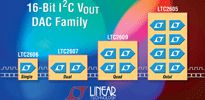Octal 16-bit ADC with 1²C interface
27 July 2005
Analogue, Mixed Signal, LSI

Linear Technology's LTC2605 is an octal 16-bit voltage output DAC with an I²C serial interface in a 16-pin SSOP package - same board area as an SO-8. At 16-bits, the company claims it is the industry's smallest footprint for an octal DAC while improving DC performance. The device's guaranteed monotonic performance, small size and low power make it ideal for digital calibration, trim/adjust and level setting applications in a variety of products. The LTC2605's output buffers deliver superior drive capability over the entire 2,7 to 5,5 V supply range. It can directly drive capacitive loads up to 1000 pF or current loads up to 15 mA and maintain good linearity to within millivolts of rail. The low 9 mV output offset provides a starting code voltage close to ground. Low output voltage noise (15 μVp-p) reduces the need for output filtering. Full-scale transition on seven of the eight DACs causes less than 10 μV change in the eighth DAC - eliminating crosstalk error. The low 250 μA supply current per DAC at 3 V and 1 μA shutdown current make it ideal for battery-powered applications.
Further reading:
A new era in modular I/O solutions
Rugged Interconnect Technologies
Analogue, Mixed Signal, LSI
Aerospace and defence system designers are demanding scalable and high-performance I/O solutions and while traditional mezzanine standards have proven reliable, they often fall short of meeting modern bandwidth, size, and flexibility requirements.
Read more...
High voltage instrument op-amp
iCorp Technologies
Analogue, Mixed Signal, LSI
The SGM621B is a high accuracy, high voltage instrumentation amplifier, which is designed to set any gain from 1 to 10 000 with one external resistor.
Read more...
High-speed SAR ADC simplifies design
Altron Arrow
Analogue, Mixed Signal, LSI
The ADI AD4080 simplifies data converter integration by integrating a low drift reference buffer, low dropout regulators and a 16K result data FIFO buffer.
Read more...
2-wire quad voltage output DAC
Altron Arrow
Analogue, Mixed Signal, LSI
The DAC has a 2-wire serial interface that operates at clock rates up to 400 kHz, and this interface is SMBus compatible, allowing multiple devices to be placed on the same bus.
Read more...
Dual-channel ADC for RF applications
RFiber Solutions
Analogue, Mixed Signal, LSI
The ARF0471 from Advanced RF is a dual-channel, 14-bit, 3 GSPS ADC, which features an on-chip buffer and sample-and-hold circuit.
Read more...
Infineon launches Edge Ai software solution
Altron Arrow
Analogue, Mixed Signal, LSI
Infineon has introduced DEEPCRAFT, a new software solution category brand for Edge AI and machine learning, after the company recognised the huge potential of Edge AI for the market.
Read more...
16-bit voltage output denseDAC
Altron Arrow
Analogue, Mixed Signal, LSI
The AD5766 uses a versatile four-wire serial interface that operates at clock rates of up to 50 MHz for write mode, and is compatible with SPI, QSPI, MICROWIRE, and DSP interface standards.
Read more...
AFE enables the software-defined factory
Avnet Silica
Analogue, Mixed Signal, LSI
With its software configurable analogue inputs, where each input can be configured for voltage, current, resistance, or temperature, NXP’s N-AFE enables a new level of flexibility.
Read more...
Precision voltage reference
Altron Arrow
Analogue, Mixed Signal, LSI
The ADR1001 is a fully integrated, ultra-low drift, buried Zener precision voltage reference solution in a single chip.
Read more...
Microphones enable low-power always-on state
Avnet Abacus
Analogue, Mixed Signal, LSI
TDK Corporation has announced its InvenSense SmartSound T5848 I2S microphones to enable intelligent keyword, voice command, and sound detection at ultra-low power.
Read more...

